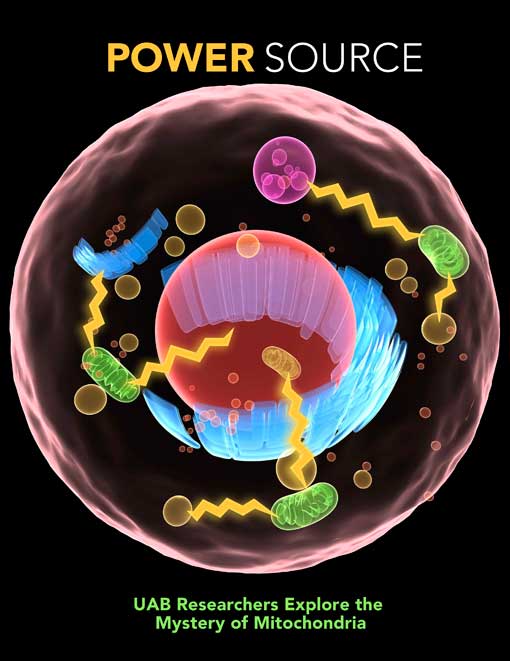By Erin Thacker
There is, at this very moment, a time capsule within your body that holds the secrets to the great deeds of your ancestors. Make that a great many time capsules, which also have some very important day jobs—namely, keeping you alive, and possibly killing you as well.
These are the mitochondria, the “powerhouses of the cell” that get their 15 minutes of fame during elementary school lessons on basic biology. Mitochondria provide the majority of the energy in most aerobic cells by using oxygen to extract the energy in food and produce adenosine triphosphate, or ATP, our body’s main energy source. But the mitochondria are much more than cellular power stations. These ubiquitous organelles are also involved in many other critical cellular processes, including growth, replication, movement, aging, and programmed cell death.
The process of producing ATP has the side effect of generating “reactive oxygen species,” or oxidants, the most infamous of which are the free radicals. These are molecules that, lacking a full complement of electrons, steal them from other molecules. This turns the victimized molecules into free radicals themselves, perpetuating a vicious cycle that can cause cellular damage or even cell death. As mitochondria age, they seem to produce more free radicals and less ATP, which some scientists argue contributes to the winding-down process that leads to our deaths.
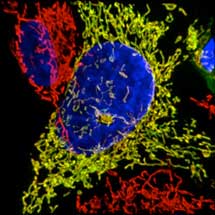 Mitochondria (red and green) surrounding the nucleus of a cell (blue). Image courtesy of
Mitochondria (red and green) surrounding the nucleus of a cell (blue). Image courtesy of
Xuejun Sun, Ph.D. Mitochondrial dysfunction also plays a role in many diseases, including cancer, diabetes, Alzheimer’s, dementia, and stroke, explains Keshav Singh, Ph.D., Joy and Bill Harbert Endowed Chair in Cancer Genetics and director of the Cancer Genetics Program in the UAB Comprehensive Cancer Center. Singh also is the founder of the national Mitochondria Research and Medicine Society, the first organization of its kind, as well as the research journal Mitochondrion.
Singh is one of a growing number of UAB scientists exploring the boundaries of mitochondrial medicine. Victor Darley-Usmar, Ph.D., a professor in the Department of Pathology and director of the Center for Free Radical Biology at UAB, says that mitochondrial research has “been a playground to develop some of the hottest ideas” in biology. In the past few decades, “we learned more about the evolution of the human race from mitochondrial genetics than we did in a couple of hundred years of archaeology.”
Calories and Consequences
Scott Ballinger, Ph.D., a professor in the Department of Pathology who specializes in the study of mitochondrial evolution, points out that our biological history plays an important role in understanding our present health issues.
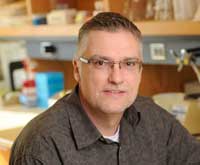 Scott Ballinger has used mitochondrial DNA to trace Scott Ballinger has used mitochondrial DNA to trace the migration patterns of prehistoric humans. |
Ballinger’s research has focused on mitochondrial DNA (mtDNA), which is entirely different from the nuclear DNA that controls our height, hair color, and other genetic characteristics. For one thing, mtDNA is much more susceptible to mutation; Ballinger has used it to trace the migration patterns of prehistoric humans over thousands of years.
“As humans migrated northward out of Africa, they accumulated an increased frequency of mutations in their mtDNA that allowed them to rapidly—from an evolutionary standpoint—deal with environmental challenges,” Ballinger says.
Mitochondrial mutations allowed our bodies to store energy when food was abundant by producing more oxidants, which prompt energy storage through insulin. But what benefited early humans can work to our detriment in today’s high-calorie, low-exercise culture. And since this switch to increased energy consumption and decreased energy expenditure is so new in evolutionary terms, our mitochondria have not had time to catch up, Ballinger notes. “Whatever your mitochondrial background is, you’re going to make more oxidants just by virtue of being inactive and eating too much, and that’s going to affect your disease susceptibility,” Ballinger says.
Energy Crisis
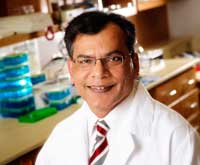 Keshav Singh is the founder
Keshav Singh is the founder
of the Mitochondria Research and Medicine Society, the first organization of its kind.The overproduction of oxidants such as free radicals eventually leads to chronic systemic inflammation that damages mitochondria and important cellular components like DNA, says Singh. And this contributes to the development of diseases such as diabetes and cancers. Exposure to environmental pollutants such as ozone and secondhand smoke can also disrupt mitochondrial function, exacerbating these disease states, he adds.
In fact, all metabolic diseases—a group that includes diabetes, and hyper- and hypothyroidism—may stem from mitochondrial dysfunction or mutation, Singh says. There is also a growing roster of hundreds of mitochondrial diseases, many of them very rare and often poorly diagnosed.
The symptoms of mitochondrial diseases can appear at any age and range from barely noticeable to completely debilitating or life threatening, Singh notes. They usually affect multiple organ systems and produce many diverse symptoms. Singh estimates that at least one in 2,000 children born in the United States will develop a mitochondrial disease, but “exact numbers are hard to determine because people who suffer from mitochondrial disease are frequently misdiagnosed,” he says. “It generally takes about 12 to 14 doctors to diagnose a patient.”
Unfortunately, even if a patient is diagnosed correctly, there is no reliable treatment for any mitochondrial disease, Singh adds. “Antioxidants seem to ameliorate the symptoms in a few cases, but not all, and high doses of antioxidants can actually have pro-oxidant effects and can make things worse.”
The Cancer Connection
Mutations in mtDNA have been identified in every cancer that has been studied, says Singh. His lab has established a link between mitochondrial dysfunction and genomic instability in the cell nucleus that leads to the development of cancer and metastasis, and his research group is now investigating methods to prevent or slow the progression of both.
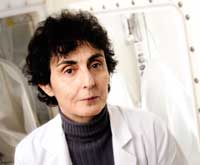 Corinne Grieger is investigating how changes in mitochondrial function may be implicated in drug resistance following chemotherapy. Changes in mitochondrial function may also be a cause of the drug resistance seen in patients who undergo multiple rounds of chemotherapy. Corinne Griguer, Ph.D., an assistant professor in the Department of Surgery, is investigating this process in brain tumors known as gliomas. Research in her lab has found that, in addition to fighting primary brain tumors, chemotherapeutic drugs such as temozolomide can alter mitochondrial function in the few surviving cells, allowing them to become drug-resistant. Tumors formed when those cells replicate are then resistant to subsequent rounds of chemotherapy.
Corinne Grieger is investigating how changes in mitochondrial function may be implicated in drug resistance following chemotherapy. Changes in mitochondrial function may also be a cause of the drug resistance seen in patients who undergo multiple rounds of chemotherapy. Corinne Griguer, Ph.D., an assistant professor in the Department of Surgery, is investigating this process in brain tumors known as gliomas. Research in her lab has found that, in addition to fighting primary brain tumors, chemotherapeutic drugs such as temozolomide can alter mitochondrial function in the few surviving cells, allowing them to become drug-resistant. Tumors formed when those cells replicate are then resistant to subsequent rounds of chemotherapy.
“The next step is to use these specific dysfunctions to develop new biomarkers for chemoresistance” along with new therapies to improve the standard of care for glioma patients, Griguer says.
Strength in Synergy
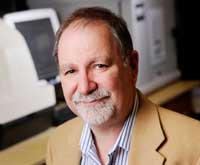 Victor Darley-Usmar's research team found that a mitochondrially targeted antioxidant could prevent some of the liver damage caused by chronic alcohol consumption.Many scientists now believe that evaluating mitochondrial function and DNA could predict individual responses to therapies. Darley-Usmar and Ballinger are now working with Robert Hardy, Ph.D., associate professor in the Department of Pathology, to develop a mitochondrial medicine lab at UAB.
Victor Darley-Usmar's research team found that a mitochondrially targeted antioxidant could prevent some of the liver damage caused by chronic alcohol consumption.Many scientists now believe that evaluating mitochondrial function and DNA could predict individual responses to therapies. Darley-Usmar and Ballinger are now working with Robert Hardy, Ph.D., associate professor in the Department of Pathology, to develop a mitochondrial medicine lab at UAB.
“Many drugs fail because they have an unidentified mitochondrial toxicity,” Darley-Usmar says, “and, on the other hand, we’re discovering now that many current therapies are actually working because they affect the mitochondria.”
Darley-Usmar’s lab has already made great advances in determining the contribution of mitochondria and oxidative stress to general cell function, as well as to cardiovascular and lung disease and kidney-related complications of diabetes. His team recently discovered that mitochondrial dysfunction induced by chronic alcohol consumption contributes to liver toxicity—and that a mitochondrially targeted antioxidant, MitoQ, could prevent some of the liver damage.
Surge Protection
The safety and efficacy of antioxidant-based therapies has not been evaluated fully, and a reliable therapy for mitochondrial dysfunction or mitochondrial diseases probably remains a few years away, Singh says. In the meantime, he can recommend one proven way to ward off free radicals and to keep mitochondria functioning smoothly: regular exercise.
In a study published in December 2011, Canadian researchers found that patients with type 2 diabetes who exercised in short, high-intensity bursts boosted the number of mitochondrial proteins in their muscles, lowered their blood sugar, and increased their maximal workload.
“Research has demonstrated that exercise can increase the number of mitochondria, reduce damage to existing mitochondria, and alleviate insulin resistance in skeletal muscles,” Singh says. “As we continue to study these intriguing structures, we will discover new insights on their roles in diabetes, cancer, and a range of other diseases.”
